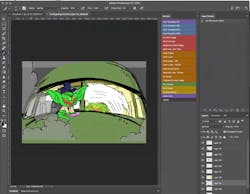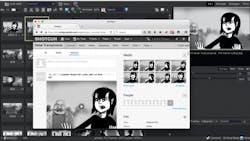FLIX Factor: Collaboration Tool Helps Usher in “Hotel Transylvania 3”
One might think that creating an animated film these days is easy due to all of the computer-generated imagery (CGI) that’s possible. The problem is that these tools make up only part of the system used to create an animated film. A lot of preparation occurs between a screenplay and rendering the movie.
One of the latest animated movies is Hotel Transylvania 3: Summer Vacation (Fig. 1). Of course, it’s the third installment in the series, with Adam Sandler returning as Drac, short for Dracula. His daughter, Mavis (Selena Gomez), announces they will be going on a cruise so that Drac can have a vacation instead of running the hotel for other vacationers. It should be great fun, but unfortunately the ship's captain, Ericka (Kathryn Hahn), just happens to be the great granddaughter of Van Helsing.
1. Hotel Transylvania 3: Summer Vacation is an animated film that was created in part using the Foundry’s FLIX story development collaboration tool.
What could go wrong? You will have to check out the movie like I will, because the rest of this article is about how much of the film was planned and created. To find out more, I talked with Yiotis Katsambas, the Director of Technology at Sony Pictures Animation , who is the architect of FLIX.
FLIX is a collaboration tool for making movies, especially animated fare. One might look at it as a massive story-board tool, but it’s much more. A typical animated film generates over 100,000 story-board panels, of which about 10,000 are actually used in the movie. Why so many others?
As it turns out, many changes occur along the way as the animated story gets fleshed out. Everything from basic content to lighting and camera angles alter the film’s presentation and how the actors will deliver their lines with respect to the animation. Such a process used to incorporate pen and paper with a whole bunch of pages tacked up on a wall. The problem was having a single wall and everyone who needed to see it or change it must be in the same room. That’s not too bad if the entire staff is in one location and it’s a relatively small team. However, these days thousands of people are involved in making a film, even on the creative side.
2. FLIX is a web-based story collaboration tool for creating animated films.
FLIX is a web-based platform (Fig. 2) that facilitates visual story creation. It started as an in-house tool for Son,y but is now available from The Foundry and used by over 30 studios. It has radically changed how directors, supervisors, cinematographers, animators, and artists work together, allowing them to be spread across the globe. Modifications can be made simultaneously to different portions of the movie by many people, with a complete history of changes available.
FLIX is integrated with other animation tools like Autodesk’s Maya, a 3D computer animation and modeling tool, or image editors like TVPaint and Adobe Photoshop (Fig. 3). FLIX acts as a repository and management system that tracks changes, including everything from panel changes to color switches. It starts up tools like Maya and then stores the alterations. It allows people at different locations to share and manipulate the content.
3. FLIX links to other editing tools like Adobe Photoshop—artists can make changes that are then saved by FLIX.
Other collaboration tools are on the market. However, FLIX is streamlined for the movie-making process, whereas most other tools are designed for other applications. It’s linked to project-management tools like Autodesk’s Shotgun (Fig. 4).
4. FLIX also integrates with project-management tools like Autodesk’s Shotgun.
If FLIX just saved a few files it might not be such a big deal, but it’s built to handle the movie-making process and the tools with which it’s integrated. For example, FLIX understands camera angles and blocking information used with tools like Maya. All of this information is saved even as different related assets are created and modified. A layout team member working on a 2D presentation can easily access the original 3D support using Maya.
It’s possible to create and store copies of animations for review by others who may not have access to all of the animation-creation tools; they can play the video, though. FLIX can also be used to collect changes, which in turn could be annotated so that others in the group can be made aware of the updates. Often these notices are to “pitch” a particular version of part of the film. Initially, this might have a dozen still images, while later versions may include complete animation sequences.
One advantage of FLIX is that it hides much of the complexity of the underlying system integration. Thus, users don’t have to be technical experts with all the tools that might be in use. They only need to concentrate on their own toolset, such as Photoshop for 2D animators. It also allows directors and supervisors to see how the overall project is progressing without having to deal directly with any of the other tools.
FLIX definitely helped the crew of Hotel Transylvania 3: Summer Vacation create another stunning animated film. Check it out for some fun summer fare.
About the Author
William G. Wong
Senior Content Director - Electronic Design and Microwaves & RF
I am Editor of Electronic Design focusing on embedded, software, and systems. As Senior Content Director, I also manage Microwaves & RF and I work with a great team of editors to provide engineers, programmers, developers and technical managers with interesting and useful articles and videos on a regular basis. Check out our free newsletters to see the latest content.
You can send press releases for new products for possible coverage on the website. I am also interested in receiving contributed articles for publishing on our website. Use our template and send to me along with a signed release form.
Check out my blog, AltEmbedded on Electronic Design, as well as his latest articles on this site that are listed below.
You can visit my social media via these links:
- AltEmbedded on Electronic Design
- Bill Wong on Facebook
- @AltEmbedded on Twitter
- Bill Wong on LinkedIn
I earned a Bachelor of Electrical Engineering at the Georgia Institute of Technology and a Masters in Computer Science from Rutgers University. I still do a bit of programming using everything from C and C++ to Rust and Ada/SPARK. I do a bit of PHP programming for Drupal websites. I have posted a few Drupal modules.
I still get a hand on software and electronic hardware. Some of this can be found on our Kit Close-Up video series. You can also see me on many of our TechXchange Talk videos. I am interested in a range of projects from robotics to artificial intelligence.






